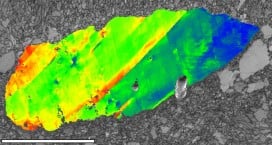This article is more than 1 year old
Whacked moon rocks yield up their secrets
What happens when you shock zircon
Since NASA is trying to find the moon rock samples it once cheerfully scattered around the world, here’s a hint: some of it is over at Curtin University in Western Australia.
However, the sample at Curtin has been put to good use: working out how to identify rocks that have suffered a meteor collision, by looking at formations in zircon present in the samples.
It’s a no-brainer (or to put things more scientifically, a long-accepted assumption) that the moon takes meteorite hits: it’s big, it’s out there, and it doesn’t have an atmosphere to slow down and/or burn any incoming meteors. However, proving that a particular rock has experienced an impact is harder.
The Curtin researchers say their examination of the samples turned up the necessary evidence: combinations of planar deformation features (PDFs, not the Adobe type), and “micro twins” that indicate impacts. These details, the researchers say, are only ever produced by large-scale meteorite impacts.
“This research is the first to report the presence of PDFs and micro twins in lunar zircon, which provide unequivocal evidence of the immense pressures that occur during an impact event,” said microstructural geology expert Dr Nick Timms, who worked on the research with Professor Steven Reddy of the WA School of Mines.
Dr Timms says the research also suggests a new explanation for the formation of these features. “As shock waves pass through a rock, fractions of a second after a meteorite impact, these features form like microscopic crumple zones which are caused by differences in zircon’s elasticity.”

Curtin University's moon rock sample
showing shock features.
All of this might seem tangential if it were only applicable to moon samples, since it’s going to be quite some time before anyone makes another trip to our satellite. However, Dr Timms says the research provides a framework for studying impact-related data.
On Earth, it’s difficult to interpret information about ancient impacts, Dr Timms explained, because so much of the physical evidence is destroyed over the ages by plate tectonics.
The new framework, he said, helps differentiate between features created by a single impact and those that require more than one impact, and it “allows us to recognize impact-related features in zircon … that would otherwise be overlooked or difficult to find.”
His work could also help researchers establish the timing of impacts on the moon, aiding research into the rest of the inner solar system. In particular, Dr Timms said, the period of the “Late Heavy Bombardment” (about 3.9 billion years ago) can be better studied. The research is published in the journal Meteoritics and Planetary Science.
The Curtin release is here. ®
